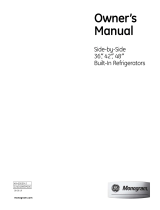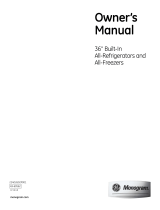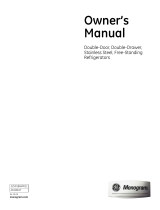5
LIRE ET CONSERVER CES INSTRUCTIONS
AVERTISSEMENT : Lorsque
vous utilisez le réfrigérateur, observez toujours
certaines précautions de base, notamment :
• N’utilisez le réfrigérateur que pour son usage
prévu, comme décrit dans le présent manuel.
• Installez le réfrigérateur conformément aux
directives d’installation avant de l’utiliser.
• Ne laissez pas les enfants grimper, s’asseoir,
se tenir debout ni se pendre aux clayettes du
réfrigérateur. Ils pourraient endommager le
réfrigérateur et se blesser gravement.
• Une fois le réfrigérateur en marche, ne
touchez pas les surfaces froides du
congélateur, surtout si vous avez les mains
humides ou mouillées : la peau risque
d’adhérer à ces surfaces très froides.
• N’entreposez et n’utilisez pas d’essence ou
autres vapeurs et liquides inflammables à
proximité de cet appareil ou de tout autre
appareil électroménager.
• Pour les réfrigérateurs dotés d’une machine
à glaçons automatique, évitez le contact avec
les pièces mobiles du mécanisme éjecteur,
ou avec l’élément chauffant situé à la partie
inférieure de la machine à glaçons. Ne posez
pas les doigts ou les mains sur le mécanisme
de la machine à glaçons pendant que le
réfrigérateur est branché.
• Éloignez les doigts des parties du
réfrigérateur où l’on peut facilement se
pincer : les espaces entre les portes et entre
les portes et les placards sont toujours étroits.
Soyez prudent lorsque vous fermez les portes
de l’appareil en présence des enfants.
• Débranchez votre réfrigérateur avant
de le nettoyer et de le réparer.
REMARQUE : Nous vous recommandons
vivement de confier toute réparation à un
technicien qualifié.
• Avant de remplacer une ampoule grillée,
mettez le commutateur de lumière principale
en position OFF (arrêt) pour éteindre la
lumière afin d’éviter tout contact avec un
fil sous tension. (Une ampoule grillée
peut se briser pendant l’opération).
REMARQUE : Lorsque vous placez les
commandes de température du réfrigérateur
sur OFF (arrêt), l’alimentation électrique
de l’ampoule n’est pas coupée.
• Ne faites PAS recongeler des aliments
surgelés qui ont complètement dégelé.
w DANGER: RISQUES POUR LES ENFANTS
Les enfants pris au piège ou morts d’asphyxie
sont toujours d’actualité. Les appareils de
réfrigération abandonés sont toujours aussi
dangereux, même si on n’attend que “quelque
jours” pour s’en débarasser. Si vous ne gardez
pas votre ancien appareil, veuillez suivre les
directives ci-dessous afin de prévenir les
accidents.
Avant de vous débarrasser de votre vieux
appareil de réfrigération :
• Démontez les portes.
• Laissez les clayettes en place afin d’empêcher
les enfants de grimper à l’intérieur.
SE DÉBARRASSER DU CFC
Votre ancien réfrigérateur peut avoir un
système de refroidissement qui a utilisé les CFC
(chlorofluorocarbones). Les CFCs sont jugés
nocifs pour l’ozone stratosphérique.
Si vous débarrassez de votre viel appareil de
réfrigération, assurez-vous que le frigorigène
avec CFC soit enlevé correctement par un
technicien qualifié. Si vous libérez
intentionnellement ce frigogène avec CFC
vouz pouvez être soumis aux contraventions
et à l’emprisonnement après les stipulations
des lois sur l’environment.






















